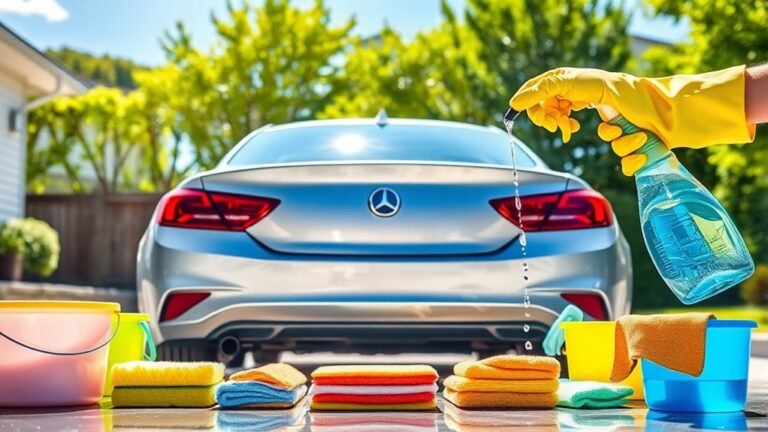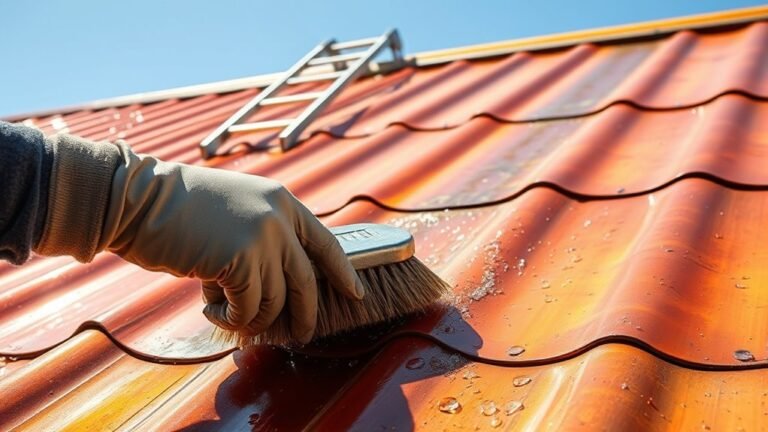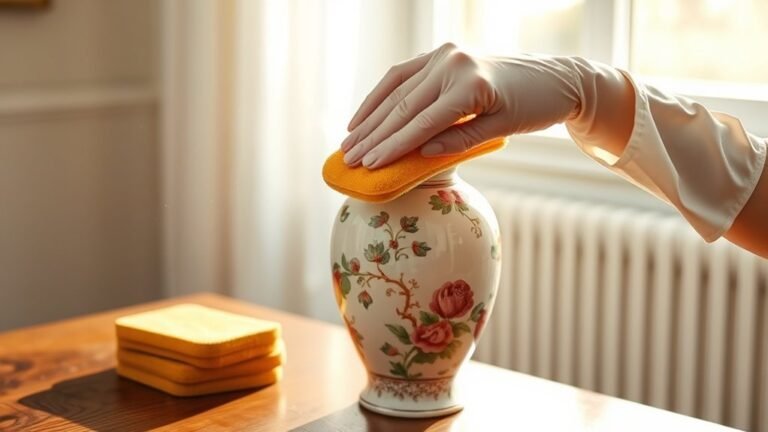How Do You Clean Polycarbonate
To clean polycarbonate, start by choosing a well-ventilated area and preparing a mild soap solution in a spray bottle. Dampen a microfiber cloth and gently wipe the surface in circular motions, avoiding abrasive materials. For stubborn stains, use a soft sponge with light pressure. Always wear gloves and goggles for safety, and remember to regularly dust the surfaces to maintain clarity. Keep going to discover more effective maintenance tips for your polycarbonate items.
##

If you’re looking to effectively clean polycarbonate without causing any damage, you’ve come to the right place. In this article, we will guide you through the best techniques and tips for maintaining the clarity and integrity of your polycarbonate surfaces. You’ll learn about suitable cleaning solutions, the right tools to use, and how to handle tough stains, ensuring that your polycarbonate remains vibrant and long-lasting. By following our advice, you’ll be equipped with the knowledge to achieve the desired results while preserving your polycarbonate’s quality.
Preparation For Cleaning
Before diving into the cleaning process, it’s crucial to gather the right materials and prepare your workspace. Start by selecting a suitable area, preferably one with good ventilation and ample light. Confirm the surface beneath your polycarbonate is protected—using a soft cloth or tarp can prevent scratches. Next, familiarize yourself with effective cleaning techniques that suit your specific polycarbonate item. Avoid abrasive materials that could damage the surface. Gather gentle, non-toxic cleaners that won’t harm the polycarbonate’s integrity. Having a soft sponge or microfiber cloth handy will help guarantee a thorough clean without leaving streaks. By taking these preparatory steps, you’ll create an ideal environment for safely cleaning your polycarbonate items.
Tools and Chemical Required

Cleaning polycarbonate effectively requires the right tools and chemicals to guarantee a safe and thorough job. To start, gather essential maintenance tools and suitable cleaning solutions. Here’s a quick reference to help you:
| Tool/Chemical | Purpose | Note |
|---|---|---|
| Microfiber Cloth | Wiping down surfaces | Prevents scratching |
| Mild Soap Solution | General cleaning | Use warm water |
| Vinegar Solution | Streak removal | Mix with water |
| Soft-Bristle Brush | Removing stubborn dirt | Be gentle |
| Spray Bottle | Application of cleaning solutions | Easy and controlled use |
With these items, you can assure your polycarbonate surfaces remain clear and undamaged while extending their lifespan.
How to Clean:

To effectively clean polycarbonate surfaces, follow this step-by-step guide to ensure optimal results:
Step 1: Gather Your Cleaning Supplies
- Soft Microfiber Cloth: This will help you gently clean the surface without scratching it.
- Mild Soap Solution: Mix a few drops of mild dish soap with warm water in a container.
- Spray Bottle: For easy application of the soap solution.
- Soft Sponge: Use this for scrubbing any stubborn spots without damaging the polycarbonate.
Step 2: Prepare the Cleaning Solution
- Fill the spray bottle with the mild soap solution you prepared.
- Shake gently to mix the solution, ensuring it is well combined for effective cleaning.
Step 3: Dampen the Microfiber Cloth
- Take the soft microfiber cloth and dampen it with the soap solution.
- Ensure the cloth is not soaking wet to avoid excess moisture on the polycarbonate surface.
Step 4: Wipe the Surface
- Gently wipe the polycarbonate surface with the dampened microfiber cloth.
- Use circular motions and light pressure to avoid scratching the surface.
- Pay attention to corners and edges where dirt may accumulate.
Step 5: Address Stubborn Stains
- For any stubborn stains or spots that remain after the initial wipe, use the soft sponge.
- Apply a little more pressure while scrubbing, but remain cautious to avoid damaging the surface.
- If necessary, reapply the soap solution to the sponge for better cleaning.
Step 6: Rinse the Surface
- After cleaning, rinse the polycarbonate surface with clean water to remove any soap residue.
- It’s best to use a gentle spray from a hose or a clean damp cloth for this step.
Step 7: Dry the Surface
- Use a separate, dry microfiber cloth to thoroughly dry the polycarbonate surface.
- Ensure that there are no water spots or streaks remaining on the surface.
Step 8: Regular Maintenance
- To keep your polycarbonate surfaces clean and clear, repeat this cleaning process regularly.
- Avoid using harsh chemicals or abrasive materials that can scratch or damage the surface.
Safety Consideration

While you’re cleaning polycarbonate surfaces, it’s essential to take into account safety precautions to protect both yourself and the material. Start by donning appropriate protective gear, such as gloves and safety goggles, to shield your skin and eyes from cleaning solutions. Make certain to work in a well-ventilated area to avoid inhaling any fumes. When handling polycarbonate, remember it’s a sensitive material; avoid using abrasive tools that could scratch or damage the surface. Always follow the manufacturer’s guidelines for cleaning materials and techniques. If you’re using chemicals, read the labels carefully and make sure you understand how to handle them safely. Maintaining these safety measures will help you achieve a clean surface while preserving the integrity of your polycarbonate items.
Tips to keep clean for long time
Maintaining the cleanliness of polycarbonate surfaces over time requires a few strategic practices that can prevent dirt and grime buildup. By implementing preventive maintenance techniques, you can extend the life and clarity of your polycarbonate items. Here are some tips to keep them clean for a long time:
- Regularly wipe surfaces with a soft microfiber cloth to remove dust.
- Apply protective coatings designed for polycarbonate to enhance resistance to scratches and UV damage.
- Avoid using abrasive cleaners or tools that might scratch the surface.
- Store polycarbonate items in a dry, shaded area to minimize exposure to harsh elements.
Frequently Asked Questions
Can I Use Vinegar to Clean Polycarbonate Surfaces?
You can’t use vinegar to clean polycarbonate surfaces. While vinegar has benefits like being a natural disinfectant and deodorizer, it can damage polycarbonate. Instead, for effective polycarbonate care, opt for a mild soap solution or a specialized cleaner. Gently wipe the surface with a soft cloth, ensuring you maintain its clarity and strength. By choosing the right cleaning method, you’ll preserve your surfaces and enjoy their durability for years to come.
Is Polycarbonate Scratch-Resistant?
Polycarbonate isn’t entirely scratch-resistant, but it does have properties that make it more durable than many other plastics. To enhance scratch prevention, you should handle it carefully and avoid abrasive materials. Use microfiber cloths for cleaning and store it away from sharp objects. When installing or using polycarbonate, consider protective coatings that can further shield the surface. By following these tips, you’ll help maintain its clarity and longevity.
How Often Should I Clean Polycarbonate Items?
You should clean polycarbonate items regularly, ideally every few weeks, depending on their exposure to dirt and grime. Maintaining a consistent cleaning frequency not only keeps them looking great but also prolongs their lifespan. Use gentle cleaners and soft cloths to avoid scratches. For best results, consider maintenance tips like rinsing them after heavy use and avoiding harsh chemicals. This way, you’ll enjoy the clarity and durability of your polycarbonate items for longer.
Can I Use a Pressure Washer on Polycarbonate?
You shouldn’t use a pressure washer on polycarbonate. The high-pressure water can cause scratches or even cracks in the surface. Instead, stick to gentle cleaning methods. For effective cleaning tips, use a soft cloth with a mild soap solution. Rinse with lukewarm water and dry with another soft cloth to avoid streaks. This will keep your polycarbonate items looking great without risking damage. Always prioritize care over convenience for long-lasting results.
What Happens if I Use Abrasive Cleaners on Polycarbonate?
Using abrasive cleaners on polycarbonate can seriously damage its surface, right? These materials can scratch and dull the clarity of your polycarbonate, ruining its appearance. Instead, opt for gentle cleaning techniques that utilize soft cloths and non-abrasive solutions. Always test any cleaner on a small area first to avoid unexpected damage. By being cautious, you’ll maintain the integrity and look of your polycarbonate, ensuring it stays clear and functional for longer.






